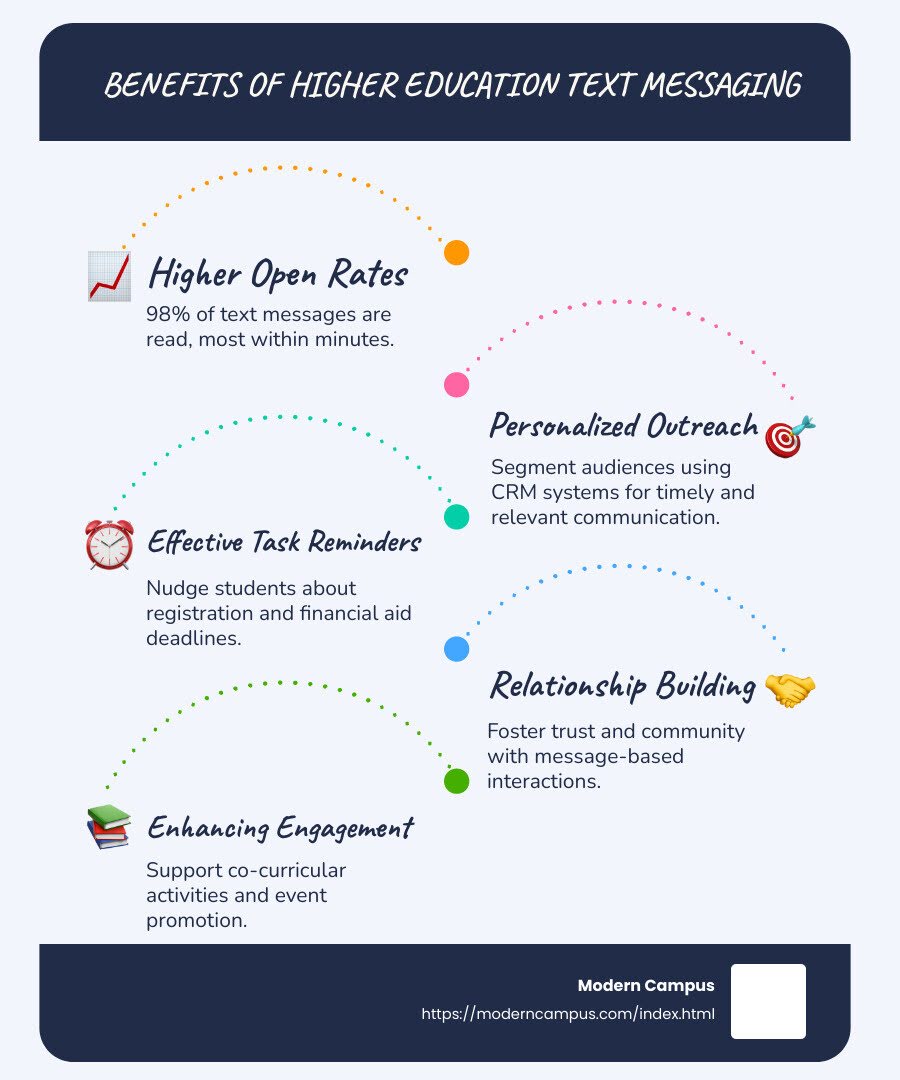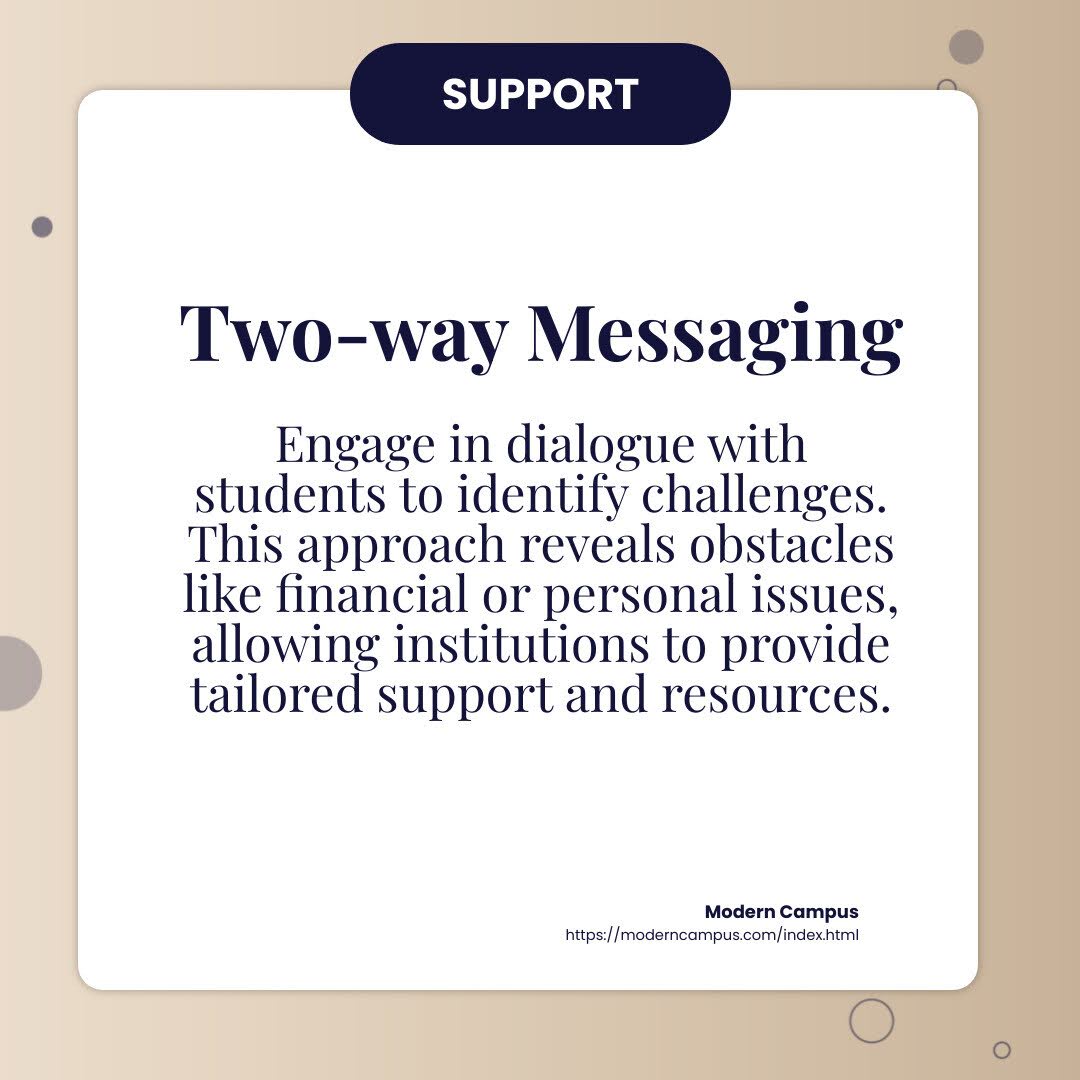Considering the Link Between Higher Ed Retention & Text Messaging
Higher education institutions are constantly seeking ways to improve student engagement and retention. Text messaging has emerged as a powerful tool to achieve these goals. Here's why:
- Immediate Communication: Over 98% of text messages are read—with 90% being opened within minutes of delivery. This swift engagement stands in contrast to email, where open rates are far lower.
- Personalized Outreach: Integrating CRM systems allows institutions to segment audiences and send targeted messages, ensuring communication is both timely and relevant.
- Task Reminders: Texts have proven effective for nudging students about important deadlines and tasks, like registration and financial aid.
- Building Relationships: Message-based interactions provide a platform for fostering trust and community, crucial elements for retention.
The link between higher education retention and text messaging involves creating a reciprocal dialogue that encourages students to feel supported and connected. Implementing well-structured communication strategies through text messaging can significantly optimize student retention and success. With this, learners not only stay on track but also thrive.

Exploring How Higher Ed Retention and Text Messaging Improve Student Success
Text messaging has become a pivotal tool in higher education, as 91% of U.S. adults owna smartphone. Many colleges and universities have leveraged this medium to enhance student engagement and retention strategies. For instance:
- Pellissippi State Community College: Engaged 86.7% of students through text messages containing academic success tips. Participants in the texting program achieved GPAs averaging 0.27 points higher than their non-participating peers after one semester.
- Austin Community College District: By sending students reminders about financial aid deadlines, upcoming workshops and money management tips, the institution increased persistence among part-time students by 15%.
- Brigham Young University: Aims to boost retention through a peer mentorship program where senior students text first-year learners, fostering a supportive academic environment.
These examples highlight the effectiveness of personalized communication in fostering student success.
Boosting Student Retention
Text messaging allows institutions to send critical information to students effectively. Communicating to students via their preferred method supports them with reminders about important deadlines, financial aid opportunities and registration dates—all of which are pivotal in keeping students enrolled and on track.
Personalized Communication
Text messaging allows for highly personalized communication, a vital component for student success. By integrating with CRM systems, institutions can segment their audiences and send custom messages. Personalization helps reduce opt-out rates and improve response rates. For example, instead of a generic message, students receive texts that address their specific needs—like a reminder for a course registration that applies to their major or year.
High Engagement Rates
Text messaging engagement rates are known to be significantly higher than other forms of communication, like email. While email open rates hover around 20%, text messages are read by nearly everyone who receives them. Immediate engagement is essential for fostering a sense of connection and support among students.
Real-Time Updates
One of the most significant advantages of text messaging is the ability to provide real-time updates. Whether it's a change in class schedules, upcoming events or urgent announcements, texts deliver timely information directly to students' phones. Institutions can help students stay informed and make prompt decisions, enhancing their overall educational experience.
Incorporating text messaging into your communication strategy improves student retention and builds a more engaged and connected student community. With personalized, timely and relevant messages, colleges and universities can significantly enhance the learner experience and support student success.
5 Ways Text Messaging Supports Student Retention
Higher education text messaging is a powerful ally in the quest to improve student retention. Let's explore five ways it can make a difference.
1. Uncover Roadblocks
Two-way messaging is a game-changer for identifying and addressing student challenges. By allowing students to respond to messages, institutions can gain insights into potential obstacles. For instance, a student might disclose financial hardships or personal issues that could affect their enrollment. An open dialogue enables personalized support, guiding students to the right resources like financial aid or academic advising.

2. Remind Students to Complete Important Tasks
Reminding students to complete important tasks is a proven strategy for driving higher retention rates in higher education. Text messaging solutions offer a direct and effective way to nudge students about critical deadlines such as financial aid applications, course registration or payment due dates. With the immediacy and near-universal reach of text messages, institutions can ensure students receive timely reminders without the risk of emails being overlooked or missed.
By implementing targeted text messaging campaigns, colleges and universities have seen measurable improvements in higher ed retention and text messaging efforts. For example, sending personalized reminders about financial aid deadlines helps students avoid unnecessary obstacles. At the same time, alerts about academic workshops and support resources empower them to stay on track. Personalized and proactive communication fosters a sense of support, contributing to students’ academic success and their likelihood to persist toward graduation.
3. Build Relationships
Building relationships with students is a cornerstone of fostering a supportive academic environment and text messaging solutions offer an effective, personalized approach to achieving this. , Institutions can create a stronger sense of community and belonging by sending encouraging messages, congratulating students on milestones, or simply checking in to see how they’re doing. Consistent communication helps students feel valued and supported, which is critical for maintaining engagement.
Text messaging also enables advisors, faculty and mentors to maintain regular, low-effort contact with students—even outside of formal meetings. Ongoing interactions can bridge gaps and make students more likely to reach out when challenges arise. As a result, institutions that prioritize relationship-building through personalized and frequent communication see higher engagement and retention. What’s more, this creates a positive ripple effect on both academic success and student satisfaction.
4. Encourage Engagement
Promoting co-curricular activities through text messaging is an effective way to enhance student involvement, which directly contributes to higher retention rates. Text messaging provides a direct and immediate way to inform students about upcoming events, volunteer opportunities and student club meetings. With this, students are able to stay connected to campus life. Unlike emails or posters, text messages are nearly impossible to ignore—an ideal way to drive awareness and participation.
By leveraging text messaging solutions, institutions can personalize outreach based on student interests and past participation, making communication more relevant and impactful. For instance, a quick text inviting a student to a career fair or a club meeting aligns with their goals and creates a sense of belonging. These connections foster a deeper engagement with the campus community. Integrating higher ed retention and text messaging strategies ensures students not only attend classes but also feel supported and actively involved. With this level of engagement, they’re more likely to stay enrolled and thrive in their academic journey.
5. Provide Timely Information
The immediacy of text messaging empowers institutions to deliver real-time updates on critical matters, ensuring students stay informed and responsive. Whether it's a class cancellation, a rescheduled event or a campus safety alert, text messaging enables institutions to communicate with students instantly—cutting through the noise of crowded email inboxes or outdated bulletin boards. Fast and efficient communication builds trust and reliability, as students know they can count on timely updates when it matters most.
Advanced text messaging solutions also allow institutions to segment their messages, targeting specific groups with information tailored to their needs. For example, only students enrolled in a particular class can be notified of a cancellation or attendees of an event can be informed about a venue change. By delivering precise, real-time information, institutions can improve operational efficiency and enhance the overall student experience. As a result, they’re able to foster a sense of preparedness and connection to the campus community. Keeping students informed in the moment is a critical component of delivering a modern, student-focused educational experience.
Higher education retention and text messaging go hand in hand. By leveraging text messaging to uncover roadblocks, send task reminders, build relationships, engage students and provide timely updates, institutions can effectively support student success and persistence.
Best Practices for Implementing Text Messaging in Higher Ed
Implementing text messaging in higher education can significantly improve student engagement and retention. To maximize its effectiveness, consider these best practices: personalization, opt-in compliance and message timing.
Harnessing Personalization to Engage Students Through Text Messaging
Personalization is key to making your messages resonate with students. Tailoring texts to individual needs and contexts increases the likelihood of engagement. For instance, using a student's name and referencing specific details (like their major or year) can make a message feel more relevant and less like a mass communication. A personalized approach can lead to better outcomes, such as higher GPAs and increased student retention.
- Use CRM or SIS data to segment your audience and craft targeted messages.
- Incorporate personal details like deadlines specific to a student's program or reminders for events related to their interests.
- Address students by name to create a personal connection.
- Use past engagement data to tailor messages to individual preferences.
- Offer relevant recommendations, such as events or resources.
- Keep the tone friendly and conversational to encourage engagement.
- Avoid overloading with too much information; focus on one clear message.
- Regularly update personalization criteria to reflect students’ evolving needs.
Maintaining Opt-In Compliance: Ensuring Trust and Transparency in Text Messaging
Opt-in compliance ensures that your text messaging efforts are both ethical and legal. Students should have the ability to choose whether they want to receive messages and institutions must respect these preferences.
- Obtain explicit consent from students before sending any text messages.
- Provide easy opt-out options in every message to maintain trust and compliance with regulations.
- Update your contact lists regularly to reflect students' current preferences and ensure that messages are only sent to those who have opted in.
Mastering Message Timing: Reaching Students When It Matters Most
Timing is everything when it comes to effective text messaging. Sending messages at the right time increases the chances of them being read and acted upon.
- Avoid sending texts late at night or early in the morning, as this can be intrusive and unwelcoming.
- Consider time zones to ensure messages arrive during appropriate hours for all students.
- Limit the frequency of messages to prevent overwhelming students, which can lead to higher opt-out rates.
- Send messages during peak engagement times, like mid-morning or early afternoon.
- Avoid sending texts during weekends unless it's urgent.
- Schedule reminders a few days before key deadlines to give students ample time to act.
- Use real-time alerts for urgent updates like class cancellations or safety notifications.
- Space out non-urgent messages to prevent overwhelming students.
- Test different timing strategies and analyze response rates to optimize delivery.
- Consider time zones for online or remote students to ensure relevance.
By focusing on personalization, ensuring opt-in compliance and carefully considering message timing, institutions can effectively improve higher ed retention and text messaging strategies for enhanced student engagement. Your institution can build meaningful connections and support students throughout their academic journey.
Design Your Own Texting Campaign with a Comprehensive Solution
Effective communication plays a pivotal role in student success. Text messaging is a powerful tool for institutions aiming to enhance student engagement and retention. By delivering timely and relevant updates directly to students, institutions can address common challenges like missed deadlines, lack of clarity on resources or feelings of disconnection from campus life. This form of communication meets students where they are—on their phones—helping to keep them informed and actively involved in their academic journey.
Higher ed retention and text messaging go hand in hand because this method provides a proactive way to build meaningful connections with students. Texts can be used to send reminders about registration dates, share information about campus events or check in with students who may be at risk of disengagement. These small but impactful actions demonstrate institutional care and foster a sense of belonging, which is key to retaining students through to graduation and beyond.
At Modern Campus, we understand that students aren’t just looking for a degree—they’re looking for a partner in their educational and career journey. Our technology enables institutions to use text messaging as part of a larger strategy to create personalized, engaging experiences for every student.
Through our integrated solutions, we empower colleges and universities to leverage text messaging alongside other tools to foster relationships, improve retention and enhance the overall student experience. Explore how Modern Campus can help you deliver the modern learner experience that today’s students expect.
Last updated: February 11, 2025

